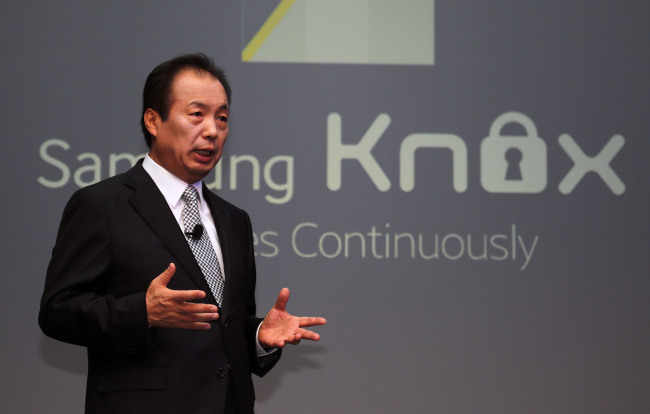Although not without challenges, Samsung Electronics appeared to be set to take on new competition with its flagship Galaxy S5 smartphone and wearable devices that it unveiled at the Mobile World Congress 2014 in Barcelona this week.
Starting with the S5, the most impressive features were the fully water-resistant body, coupled with up-to-date technologies such as a fingerprint scanner and a heart-rate monitoring sensor.
The so-called “download booster,” which allows users to utilize both the Wi-Fi and LTE networks to increase transfer speeds, seemed to be another appealing factor to customers.
 |
Samsung Electronics’ mobile chief Shin Jong-kyun speaks Tuesday at the “Samsung Enterprise Mobility Media Event,” in which Samsung unveiled the Knox 2.0 security solution at the Mobile World Congress in Barcelona, Spain. (Samsung Electronics) |
Shin Jong-kyun, chief of the Korean tech giant’s IT and mobile division, painted a rosy picture for the latest handset by saying that the “the market response (for the new smartphone) is great.”
Known to be a man of few words, it seemed unlikely for Shin to be so confident unless he had gotten good feedback from major retailers and distributors who Samsung had met months before the introduction in Barcelona.
The Knox 2.0, the mobile security solution installed on the latest Galaxy model, will also play a key role for Samsung to be able to retain the top position in the global mobile market as it will prove to be the most stable and safest mobile security platform, Shin said.
Last but not least, the Samsung mobile chief is betting big on wearable products as he said wearable devices have become a mainstream trend at the mobile trade show.
Samsung introduced the Samsung Gear 2, Samsung Gear 2 Neo and Samsung Gear Fit this week.
The Samsung Gear Fit especially received much attention from the news media and the public as it boasts a sleek design, fitted with the world’s first curved display, and improved fitness functions such as the heart-rate monitoring system.
However, there are some concerns that the Korean tech firm will face a tougher battle in retaining the top position in the global mobile market this year as its latest Galaxy S5 smartphone failed to wow the audience.
“There was nothing new in the Galaxy S5 in terms of design and function,” said Kim Hye-yong, analyst from Woori Investment and Securities, adding that most of the specifications were already anticipated.
Critics also said some of the new features had also been adopted by mobile device makers such as Sony and Apple.
Some analysts said the Korean firm changed its marketing strategy in the face of cutthroat global competition.
“Samsung seems to have shifted its focus away from hardware improvement, and toward better pricing policies,” Nam Dae-jong, an analyst from Hana Daetoo Securities, said in a research report, hinting that the S5 may be priced lower than previous Samsung flagship phones.
Emerging Chinese handset makers pose another risk for Samsung.
Huawei and ZTE, Chinese smartphone manufacturers, showcased their own budget handsets Ascend G6 and Grand S2, respectively, at the mobile trade show.
“As smartphone makers usually use displays, chips and other components from the same supplier, the final products show little distinction,” said an executive of a fingerprint sensor company. “The Chinese mobile companies are indeed a serious threat.”
By Kim Young-won (
wone0102@heraldcorp.com)








